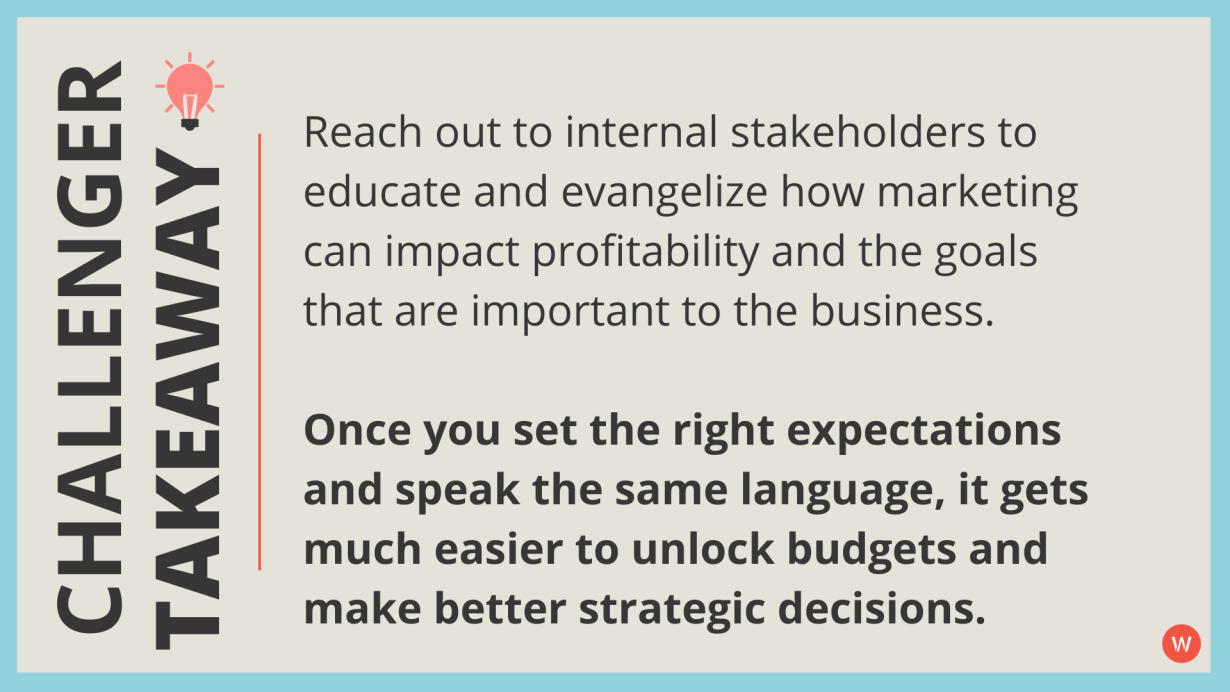The Silicon Valley-inspired ideal of infinite growth is no longer front-of-mind for most businesses. Facing an uncertain economy, leaders are shifting to a new goal: profitability. That opens up many opportunities for marketers who successfully connect their activities to their impact on business outcomes.
But you have to have the right tools in place to make the case for marketing’s ability to accelerate profitability: integrated media strategy, dynamic agile budgets, and measurement that keeps every ad dollar accountable across the funnel.
That’s why we tapped in a panel of top marketing leaders to show us the way: Bruce Biegel, Senior Managing Partner at Winterberry Group; Melissa Bell, Global Chief Marketing Officer for 2K; and Sammy Rubin, Head of Media Strategy at Wpromote.
We’re sharing their insights so you can prepare your brand for the strongest possible year by leveraging the powerful combination of technology and marketing expertise to build an engine aimed at profitability.
You need better analytics to identify and prioritize marketing levers that affect profitability
When we polled our audience during the live event The Profitability Imperative, the majority said they were being asked to do more with less budget. That’s impossible if you don’t understand which marketing levers actually make an impact on profitability and how and when to pull them, according to Winterberry’s Bruce Biegel
You need a strong analytics foundation to translate marketing performance across the funnel into business outcomes, including brand marketing. 2K’s Melissa Bell points to analytics as the essential component to not just understanding how different actions affect outcomes in the short-term, but long-term profitability.
“We’ve put together something called metrics that matter, so we can understand the purpose of what we’re doing. When we look at branding-based activities, we may have more lagging indicators via brand health studies and things like that, then we have more leading indicators for conversion tactics. It’s a balancing act because you want to grow the brand and convert at the same time.”
Sammy Rubin of Wpromote stresses that leaders aren’t just looking at efficient acquisition anymore, they’re prioritizing profitable acquisition. To make that happen, marketers need to be able to see the incremental impact marketing has on the business, which requires different analytics capabilities.
That includes incrementality testing to prove that impact, but it goes deeper than that: you need to be able to understand the attributes of the highest-value audiences based on lifetime value (LTV). To make sure you’re prioritizing acquiring those higher-value customers that will drive sustainable long-term growth, you need to be able to pull insights out of your CRM and first-party data.
Accompanying profitable acquisition is a renewed focus on retention marketing. Businesses want to know how to get more out of existing customers in incremental ways through different types of basket-building or repeat purchase occasion-type initiatives. Marketing also has a role to play in the product conversation around profitability by prioritizing different products or promotional offers based on the need to liquidate inventory or based on profit margin strategies.

You have to be willing to shift your marketing mix. Get started by asking: “where would I put my worst-performing dollar or bottom 5% of paid media spend?” Shake up your thinking by constantly assessing if your marketing efforts are working or if you need to spend your dollars elsewhere.
But the current state of data privacy makes all of this a little harder. Signal loss is inevitable, and your analytics need to be ready to meet that challenge. That starts with attribution.
It’s critical that marketers begin to transition away from last-click attribution and toward measurement solutions that are focused on the customer, broader business results, and lift. Your analytics must deliver actionable insights and a clear connection to business outcomes or you’re doomed to keep repeating the same mistakes.
That won’t be easy because there is still a lot of work to be done to build solutions that can deliver those deep insights efficiently and effectively, especially if you’re looking for an integrated, omnichannel view that is also privacy compliant. But the brands that get started now and invest in better analytics will be well-positioned against the competition in this new world.
“The holy grail is the 360 degree view of the customer. I think if we get somewhere around maybe 250, we’d be great. We’re not even there yet. From a use case standpoint, we are just beginning to tap the availability of the data that we have and leverage it. From a maturity standpoint, we are still pretty early in the market.”
You need alignment and accountability to build a marketing strategy that accelerates profitability
You can’t make these necessary adjustments alone; there are many internal stakeholders that need to understand how marketing can help achieve profitability and what you need to have in place to make that impact. That means you need to be educating and evangelizing the role marketing will play with executives, finance, and other leaders.
Once you set the right expectations and speak the same language, you’ll be able to unlock the budgets and agility you need and make smarter strategic decisions.
Biegel says that CFOs are more outcome-driven than ever before because, while revenue has been going up, earnings have not. When earnings get squeezed, CFOs will turn to the CMO and tell them to squeeze. The very first conversation with the board is going to look at the 8-9% spent on marketing and ask how to get the most out of that spend.

That means every dollar needs to be more accountable than ever and without a mature measurement strategy in place that’s impossible.
Rubin believes that many brands are doubling down on investing in marketing activities that are getting attribution in Google Analytics (GA) and missing out on what’s actually driving inspiration and discovery throughout that user journey. In fact, channel attribution in GA wasn’t ever the “right” way to look at things. As it becomes less and less accurate you need to identify the leading/lagging indicators are aligned with your bigger goals, especially when it comes to brand marketing and the upper funnel.
“Getting to that level of measurement sophistication requires internal stakeholders across marketing, finance, strategy teams to be in lockstep on what are they trying to accomplish so that the types of tests that can help unlock that more mature measurement don’t get killed prematurely. That puts the business at risk of losing those insights.”
The end goal is to not just look at those performance analyses from a retroactive standpoint, but use that data to power predictive modeling once you have a critical mass. That’s where media mix models like Wpromote’s high velocity Growth Planner come into play, which unlocks complex scenario planning for the businesses we partner with.

For Bell, last-click attribution continues to be a specter that keeps marketing leaders up at night as the pressure to show results from other stakeholders like revenue or finance increases, especially for a business with a lot of critical offline touchpoints. The temptation to look at known channels like Facebook just because they have more analytics capabilities is high, even if that’s only 10% of the data. To solve that problem, it’s essential to do two things: look at the full customer journey and recognize that signal loss is going to happen.
That’s where human expertise comes in; the right teams need to be empowered to make necessary judgments, particularly where there are gaps in the data. You can and should plug as many holes as you can on the analytics side, but it will never be 100%. That’s why Bell recommends using analytics and data to guide those decisions at all times, but relying on experts to make the final decisions.







Responses